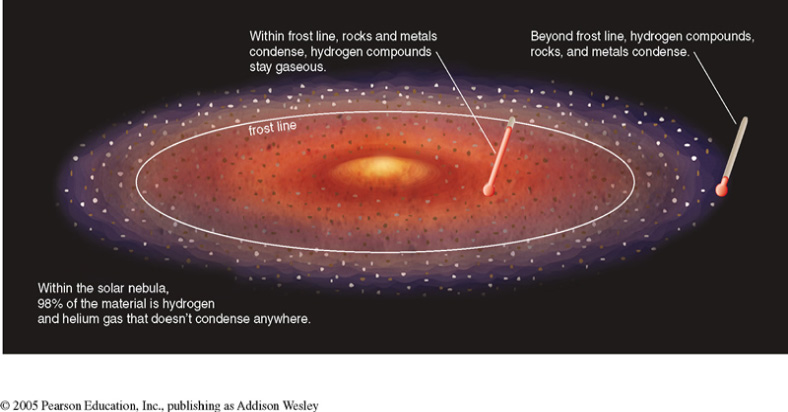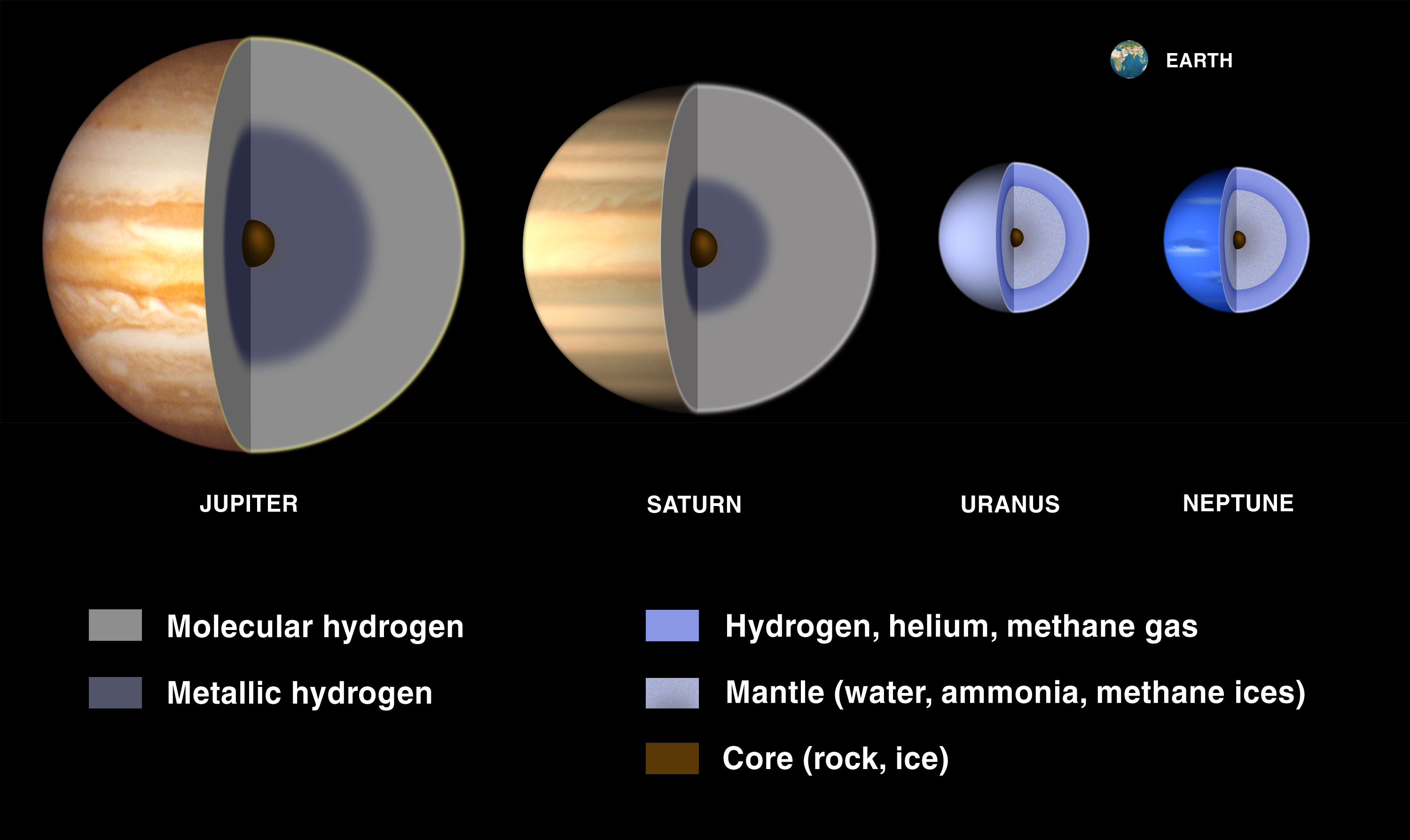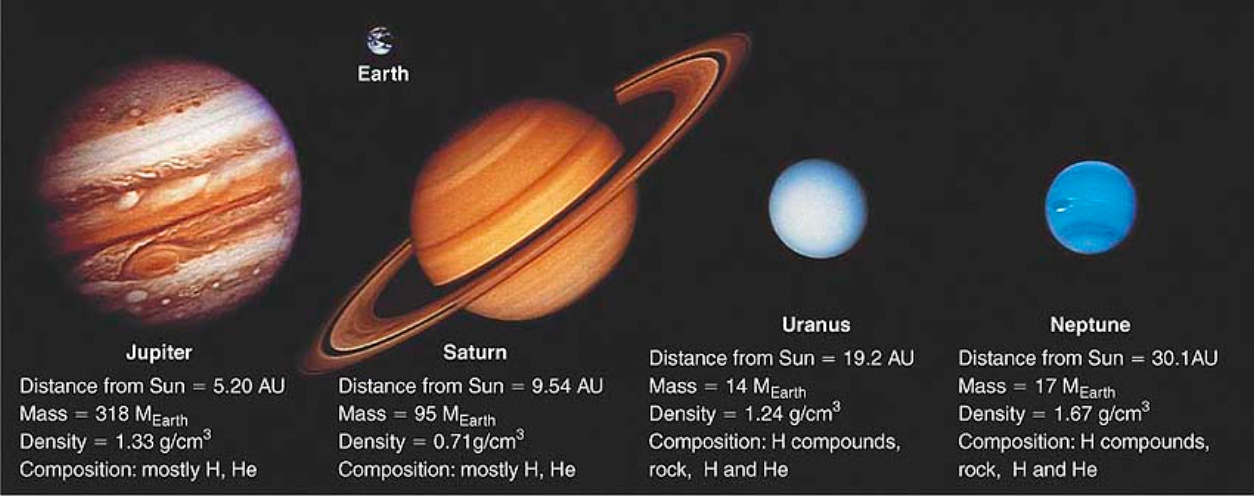Important! Why Are The Gas Planets Further From The Sun
The average distance between the Earth and the Sun is called the astronomical unit AU which is about 150 million km 15 x 108 km. Planets including Mercury Venus Earth and Mars are rocky planets and are small compared to gas giants.

Picture Of Pluto Further Refined By Months Of New Horizons Data Atmospheric Gases Planetary Science Kuiper Belt
There is less volume in the inner solar system compared to the outer solar system so there was less material present in the protoplanetary disk to form planets much larger than the terrestrial planets.

Why are the gas planets further from the sun. Some of my friends are arguing how gas giants were created far from the Sun while the rocky planets were in the inner orbits. But mass is directly proportional to force. Jupiter Saturn Uranus and Neptune.
Gas planets refer to the giant planets in our Solar System which are furthest to orbit the Sun and made of yeah you guessed it. In the Beginning of the Solar system the Proto-Sun was more Luminous and Radiant than it is today about 10-20 times more Luminous. Theres just so many incorrect answers I had to point this out.
All of the planets in our Solar System began to form this way but close to the Sun the temperature was too high for volatiles gases like water and methane to condense so only the materials with a higher melting point and higher density were able to form at this point. They have too much energy and therefore must remain in a gaseous state. Answer 1 of 6.
The densities of the gas giants are much less than the densities of the rocky terrestrial worlds of the solar system. Most studies in this area have focused on the inner planets. Planets further from the sun are much more easily able to get a huge gaseous envelope- the Sun is pulling that away from them less.
The reasons why some planets rotate as quickly as they do remain puzzling to planetary scientists. One of the ideas is at first they were all the same. For example the boulder in the picture alone weighs 14 million pounds to have 14 million pounds of gas I assume that a lot of gas would be needed and it.
The four planets farthest from the Sun are the outer planets. Also the inner planets didnt have the gravity to gather that kind of deep dense atmo. Since they are so far out they take longer to complete their orbit around the sun.
Further out the temperature was low enough for some gases to solidify and due to the abundance of these gases the gas planets were able to initially grow larger than the inner planets. The article says that the sun is made of plasma and gas. If this is the case how is it that the earth which is solid weighs less than the sun and the gas planets in our solar system.
The planets far from the Sun arent frozen. As gas and dust circulates in the accretion disk after stellar ignition the heavier elements continue in their tight orbits as. The gas and ice giant planets take longer to orbit the Sun because of their great distances.
This eventually allowed them to gather enough mass to be able to capture very light elements such as hydrogen and helium which enabled them to grow to such. It is by far the most important source of energy for life on EarthIts diameter is about 139 million kilometres 864000 miles or 109 times. The gas and ice giant planets are all located in the outer perimeters of our solar system.
What are the gas planets. Now before you go around and spit off how much you know about the gas planets. This region is the minimum distance from the sun where temperatures are low enough to allow those ices I mentioned previously to condense as.
Still another reason why the latter planets have more Sun-like compositions than the terrestrials is because they formed out beyond the frost line. Despite these objects different sizes they stayed more or less on the same plane where their building materials originated. Gas giants then the solar wind blew the outer layers of the inners and they became rocky.
The Sun is the star at the center of the Solar SystemIt is a nearly perfect sphere of hot plasma heated to incandescence by nuclear fusion reactions in its core radiating the energy mainly as visible light ultraviolet light and infrared radiation. The farther away they are the more time it takes to make one trip around the Sun. And all these planet are near to Sun.
Thats why even today the solar systems eight planets and other. The Sun was radiant enough to drive away gas from the inner Solar system leaving behind the rocky cores which are now terrestrial planets. Answer 1 of 2.
The Sun was radiant but it was radiant enough to drive all the gas away from the outer Solar system thus those rocky cores. Saturn is probably pretty much the sam. A How far is Jupiter from the sun in astronomical.
And if gas giants lie farther always they why does Pluto lie after all the gas. Why are the planets closer to the Sun not larger and why is the composition of the gasrock planets different as you move away from the Sun. So why dont any planets lie between rocky planets.
These planets are much larger than the inner planets and are made primarily of gases and liquids so they are also called gas giants. In the inner Solar System the temperature is warmer and the light elements - hydrogen and helium - cannot freeze out. Unfortunately the other answers in this feed fall short of an accurate description.
Our terrestrial planets may be higher in density that the gas giants but unlike the name the gas giants arent completely made up of gas. Jupiter is 780 million km from the sun. Why do the outer gas-giant planets generally rotate much faster than the inner terrestrial planets.
As you get closer to the Sun gas starts either getting blown away or pulled in by the Sun so doesnt give planets much opportunity to hold onto much of anything. Jupiter is gas mostly hydrogen but it has a beautiful helium-neon rain until you get to the incredible liquid metallic hydrogen core which might be liquid we dont really know. The gas giants on the other hand formed far enough away from the Sun.
Answer 1 of 10. Hot Neptunes- and their even bigger counterparts known as hot Jupiters - are gas giant planets that orbit very close to their star often much closer than. Figure below shows the relative sizes of the outer planets and the Sun.
The closest it gets to the sun is 44 billion. The Solar System formed from a spinning disc of gas dust and ice surrounding the young Sun the solar nebula Close to the Sun rings of dust orbited much faster than those further out.

Moons By Dckiq Deviantart Com On Deviantart Planets And Moons Space And Astronomy Planet Design
Why Are Planets Closer To The Sun More Dense

The Outer Planets How Planets Form

The Dwarf Planet Eris Is Three Times Further From The Sun Than Pluto Planets And Moons Planets Dwarf Planet

Infographic Solar Systems Via Milky Way Lovers At Facebook Strange Orbits Of Planets In Other Systems Seem Solar System Matter Science Solar System Projects

Temperatures Of The Planets In Our Solar System Space Outerspace Infographic Planets Education Satur Solar System Planets Uranus Planet Our Solar System

Gas Giant Interiors 2003 Nasa Solar System Exploration
Why Do Gas Giants Often Have Dozens Of Moons Quora

Ever Wondered Why Do Gas Giants Occupy The Outer Solar System

Ever Wondered Why Do Gas Giants Occupy The Outer Solar System

The Outer Planets Giant Planets What Are They And Where Are They

The Inner And Outer Planets In Our Solar System Universe Today

My Son S 5th Grade 3d Solar System Project A Science Sun Planets Stars Asteroids Gas Gi Solar System Projects 3d Solar System Project Solar System

The 4 Inner Planets Are The Closest To The Sun And The Outer Planets Are The Other Four Jupiter Saturn Uranus And Nept Outer Planets Planets Solar System

Uranus Moon Titania Nasa Planets Uranus Moons Of Uranus